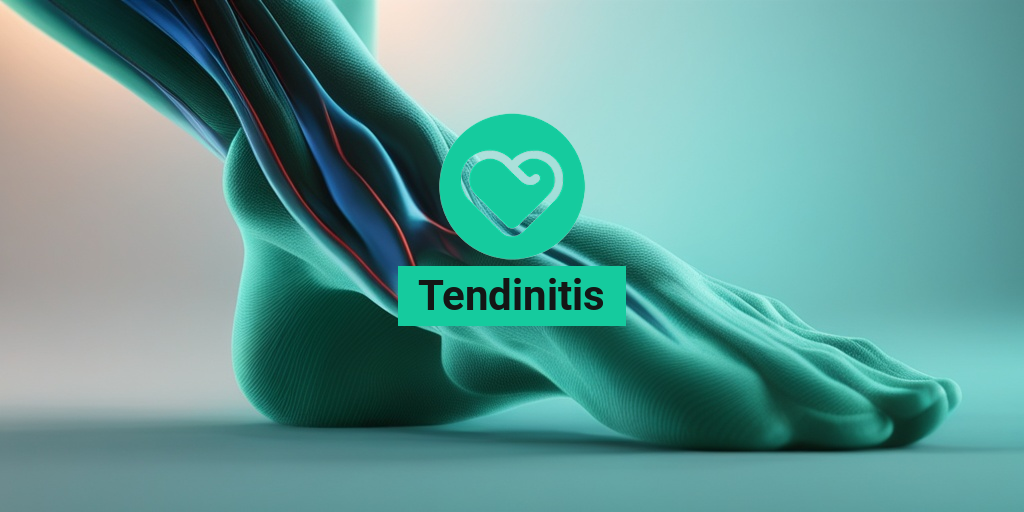What Is Tendinitis?
Tendinitis is a common condition that affects millions of people worldwide. But what exactly is tendinitis, and how does it impact our daily lives? In this article, we’ll delve into the world of tendinitis, exploring its definition, symptoms, causes, and treatment options.
Definition of Tendinitis
Tendinitis is a type of inflammation that occurs in the tendons, which are fibrous cords that connect muscles to bones. When a tendon becomes inflamed, it can cause pain, stiffness, and limited mobility in the affected area. Tendinitis can occur in any part of the body, but it’s most common in the shoulders, elbows, wrists, knees, and heels.
Causes of Tendinitis
Tendinitis can be caused by a variety of factors, including:
- Overuse or repetitive strain: Repeatedly performing the same motion can put excessive stress on the tendons, leading to inflammation.
- Aging: As we age, our tendons naturally degenerate, making them more prone to inflammation.
- Injury or trauma: A sudden injury can cause tendon inflammation, especially if it’s not properly treated.
- Medical conditions: Certain conditions, such as arthritis, gout, or thyroid disorders, can increase the risk of developing tendinitis.
Tendinitis Symptoms
The symptoms of tendinitis can vary depending on the location and severity of the inflammation. However, common symptoms include:
Pain and Stiffness
Pain is the most common symptom of tendinitis, and it can range from mild to severe. The pain may be constant or it may come and go, depending on the activity level. Stiffness in the affected area is also common, making it difficult to move the joint or perform daily activities.
Swelling and Redness
In some cases, tendinitis can cause swelling and redness in the affected area. This is usually accompanied by warmth or heat, which can be uncomfortable and painful.
Weakness and Fatigue
As tendinitis progresses, it can cause weakness and fatigue in the affected muscle group. This can make it difficult to perform everyday activities, such as lifting, bending, or walking.
Now that we’ve covered the basics of tendinitis, it’s essential to seek medical attention if you’re experiencing any of these symptoms. Early diagnosis and treatment can make a significant difference in managing tendinitis and preventing further complications. 🏥
Stay tuned for our next article, where we’ll explore the treatment options for tendinitis and how Yesil Health AI can provide valuable insights and evidence-based health answers. 💡

Types of Tendinitis
Tendinitis is a common condition that affects millions of people worldwide. It’s a type of inflammation that occurs in the tendons, which are the tissues that connect muscles to bones. While tendinitis can occur in any part of the body, there are some areas that are more prone to this condition. Let’s take a closer look at the different types of tendinitis:
Achilles Tendinitis
Achilles tendinitis is a common type of tendinitis that affects the Achilles tendon, which connects the calf muscles to the heel bone. This type of tendinitis is often seen in athletes who participate in sports that involve running or jumping. Symptoms of Achilles tendinitis include pain and stiffness in the heel area, especially after exercise.
Rotator Cuff Tendinitis
Rotator cuff tendinitis affects the tendons in the shoulder joint. This type of tendinitis is common in people who perform repetitive overhead movements, such as tennis players or swimmers. Symptoms of rotator cuff tendinitis include pain and weakness in the shoulder area, especially when lifting or rotating the arm.
Patellar Tendinitis
Patellar tendinitis affects the tendon that connects the kneecap to the shinbone. This type of tendinitis is common in athletes who participate in sports that involve jumping, such as basketball or volleyball. Symptoms of patellar tendinitis include pain and swelling in the front of the knee, especially after exercise.
Wrist Tendinitis
Wrist tendinitis affects the tendons in the wrist joint. This type of tendinitis is common in people who perform repetitive movements with their hands, such as typing or using vibrating tools. Symptoms of wrist tendinitis include pain and stiffness in the wrist area, especially after activity.
Tendinitis Causes and Risk Factors
Tendinitis can occur due to a combination of factors, including overuse, injury, and underlying medical conditions. Let’s take a closer look at the common causes and risk factors of tendinitis:
Overuse
Overuse is one of the most common causes of tendinitis. When you perform repetitive movements, you put excessive stress on your tendons, leading to inflammation and pain. Activities that involve repetitive movements, such as running, jumping, or lifting, can increase your risk of developing tendinitis.
Injury
Injury is another common cause of tendinitis. A sudden injury, such as a fall or a blow to the affected area, can cause inflammation and pain in the tendons. People who participate in contact sports, such as football or soccer, are at a higher risk of developing tendinitis due to injury.
Age
As we age, our tendons naturally degenerate, making them more prone to inflammation and pain. People over the age of 40 are at a higher risk of developing tendinitis due to age-related tendon degeneration.
Underlying Medical Conditions
Certain underlying medical conditions, such as diabetes, rheumatoid arthritis, and thyroid disorders, can increase your risk of developing tendinitis. People with these conditions should take extra precautions to prevent tendinitis, such as exercising regularly and taking regular breaks to rest their joints.
Remember, tendinitis can affect anyone, regardless of age or activity level. By understanding the different types of tendinitis and their causes, you can take steps to prevent this condition and maintain healthy, pain-free joints. 💪

Tendinitis Diagnosis
Receiving an accurate diagnosis is the first step towards effective treatment and recovery from tendinitis. If you’re experiencing persistent pain or discomfort in a tendon, it’s essential to consult a healthcare professional for a proper evaluation.
What to Expect During a Diagnosis
During a diagnosis, your healthcare provider will typically perform a physical examination to assess the affected area. They may ask you to move the affected joint or limb to identify the source of the pain. They may also ask questions about your medical history, including any previous injuries or conditions that may be contributing to your symptoms.
In some cases, your healthcare provider may order imaging tests, such as X-rays or an MRI, to rule out other conditions that may be causing your symptoms. These tests can help identify any inflammation or damage to the tendon.
Common Diagnostic Tests for Tendinitis
Some common diagnostic tests used to diagnose tendinitis include:
- X-rays: To rule out other conditions, such as bone fractures or osteoarthritis.
- Magnetic Resonance Imaging (MRI): To visualize the tendon and surrounding tissues.
- Ultrasound: To evaluate tendon thickness and blood flow.
Diagnosing Tendinitis in Specific Areas
Tendinitis can occur in various parts of the body, and the diagnosis process may vary depending on the affected area. For example:
- Tendinitis of the Wrist: A healthcare provider may perform a wrist extension test to assess pain and stiffness in the wrist.
- Tendinitis of the Knee: A healthcare provider may perform a knee flexion test to assess pain and stiffness in the knee.
- Achilles Tendinitis: A healthcare provider may perform a calf squeeze test to assess pain and stiffness in the Achilles tendon.
Tendinitis Treatment Options
Once diagnosed, tendinitis can be treated with a combination of conservative and interventional approaches. The goal of treatment is to reduce pain, inflammation, and improve function.
Conservative Treatment Options
Conservative treatment options for tendinitis include:
- Rest and Ice: Avoiding activities that aggravate the condition and applying ice to reduce inflammation.
- Physical Therapy: Gentle exercises to improve range of motion and strength.
- Medications: Over-the-counter pain relievers, such as NSAIDs, to reduce pain and inflammation.
- Orthotics and Bracing: Using devices to support and stabilize the affected joint or limb.
Interventional Treatment Options
In some cases, interventional treatment options may be necessary, including:
- Corticosteroid Injections: Injecting corticosteroids to reduce inflammation.
- Platelet-rich Plasma (PRP) Therapy: Injecting platelet-rich plasma to stimulate healing.
- Surgery: In severe cases, surgery may be necessary to repair or remove damaged tissue.
It’s essential to work closely with a healthcare provider to determine the best course of treatment for your specific case of tendinitis. With proper diagnosis and treatment, it’s possible to alleviate symptoms and improve function. 💪

Tendinitis Exercises and Stretches
When it comes to managing tendinitis, exercises and stretches play a crucial role in reducing pain and inflammation, improving flexibility, and promoting recovery. In this section, we’ll explore some of the most effective exercises and stretches to help alleviate tendinitis symptoms.
Wrist Extensions
Wrist extensions are an excellent exercise for tendinitis in the wrist. To perform this exercise:
- Hold a light weight (less than 1 pound) in the affected hand.
- Slowly tilt your wrist upward, keeping your forearm still.
- Hold for 5-10 seconds, then slowly lower.
- Repeat for 10-15 repetitions, 3-4 times a day.
Finger Bends
Finger bends are another effective exercise for wrist tendinitis. To perform this exercise:
- Place a small towel or washcloth on a flat surface.
- Place your hand on the towel with your fingers extended.
- SLOWLY bend your fingers down toward your palm, keeping your wrist still.
- Hold for 5-10 seconds, then slowly release.
- Repeat for 10-15 repetitions, 3-4 times a day.
Achilles Tendinitis Stretches
For Achilles tendinitis, stretching is essential to reduce pain and inflammation. Try these stretches:
- Calf Stretch: Stand facing a wall with one hand on the wall for balance. Step one foot back about a foot, keeping your heel on the ground. Slowly bend your front knee, keeping your back leg straight. Hold for 15-30 seconds, then switch legs.
- Achilles Stretch: Stand with your affected leg behind your unaffected leg, with your feet pointing straight ahead. Slowly bend your front knee, keeping your back leg straight. Hold for 15-30 seconds, then switch legs.
Tendinitis Prevention and Recovery
Preventing tendinitis is always better than treating it. By incorporating simple habits and strategies into your daily routine, you can reduce your risk of developing tendinitis and promote faster recovery.
Proper Warm-Up and Cool-Down
A proper warm-up and cool-down are essential for preventing tendinitis. Before engaging in any physical activity:
- Warm up with 5-10 minutes of light cardio and stretching.
- Cool down with 5-10 minutes of stretching after your activity.
Proper Technique and Posture
Using proper technique and maintaining good posture can reduce your risk of developing tendinitis. Make sure to:
- Use proper form and technique when engaging in physical activities.
- Maintain good posture to reduce strain on your muscles and tendons.
Rest and Recovery
Rest and recovery are crucial for tendinitis recovery. Make sure to:
- Get plenty of rest and avoid activities that aggravate your symptoms.
- Use ice or heat therapy to reduce pain and inflammation.
- Gradually return to your normal activities to avoid re-injury.
By incorporating these exercises, stretches, and prevention strategies into your daily routine, you can reduce your risk of developing tendinitis and promote faster recovery. Remember to consult with a healthcare professional before starting any new exercise or treatment plan. 💪

Frequently Asked Questions about Tendinitis
Get answers to your most pressing questions about tendinitis, a common condition that affects millions of people worldwide.
What is Tendinitis?
Tendinitis is a condition where the tendons, which connect muscles to bones, become inflamed or irritated. This can cause pain, stiffness, and limited mobility in the affected area.
What are the Symptoms of Tendinitis?
The symptoms of tendinitis can vary depending on the location and severity of the condition. Common symptoms include:
- Pain or tenderness in the affected area
- Stiffness or limited mobility
- Swelling or redness in the affected area
- Weakness or fatigue in the affected muscle
What Causes Tendinitis?
Tendinitis can be caused by a variety of factors, including:
- Overuse or repetitive strain on a tendon
- Sudden injury or trauma to a tendon
- Aging or wear and tear on tendons
- Medical conditions such as arthritis or gout
How is Tendinitis Diagnosed?
Tendinitis is typically diagnosed through a combination of:
- Physical examination by a healthcare professional
- Medical history and symptom review
- Imaging tests such as X-rays or MRI scans
How is Tendinitis Treated?
Treatment for tendinitis usually involves a combination of:
- Rest and ice to reduce inflammation
- Pain relief medications such as NSAIDs
- Physical therapy to improve strength and mobility
- Surgery in severe cases
Can Tendinitis be Prevented?
Yes, tendinitis can be prevented or minimized by:
- Warming up and stretching before exercise
- Using proper technique and form during exercise
- Taking regular breaks to rest and stretch
- Strengthening surrounding muscles to reduce strain on tendons
What is the Difference between Tendinitis and Tendonitis?
Tendinitis and tendonitis are often used interchangeably, but technically, tendinitis refers to inflammation of the tendon, while tendonitis refers to inflammation of the tendon sheath. 🤕
Can I Exercise with Tendinitis?
It’s generally recommended to avoid activities that aggravate the condition, but gentle exercises and stretches can help improve mobility and strength. Consult with a healthcare professional to develop a safe and effective exercise plan. 🏋️♀️
How Long Does it Take to Recover from Tendinitis?
Recovery time from tendinitis can vary depending on the severity of the condition and the effectiveness of treatment. With proper rest and treatment, most people can recover from tendinitis within 2-6 weeks. ⏰




